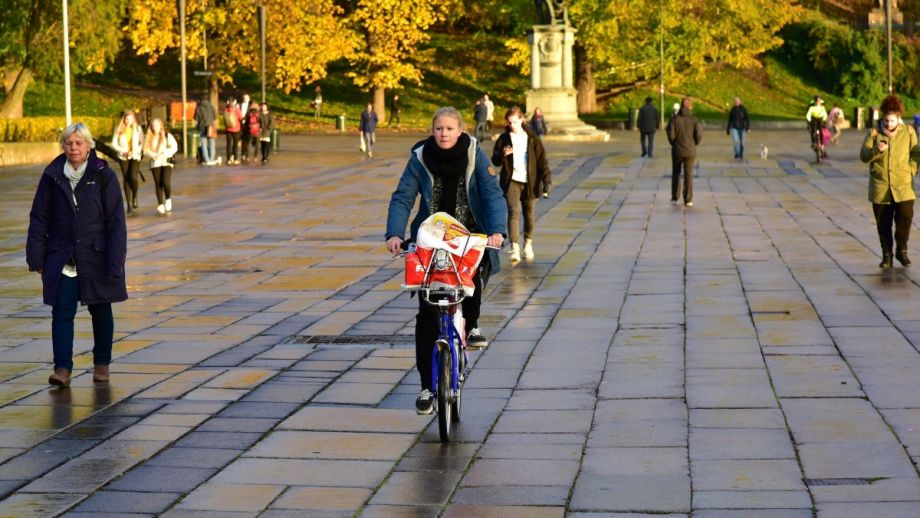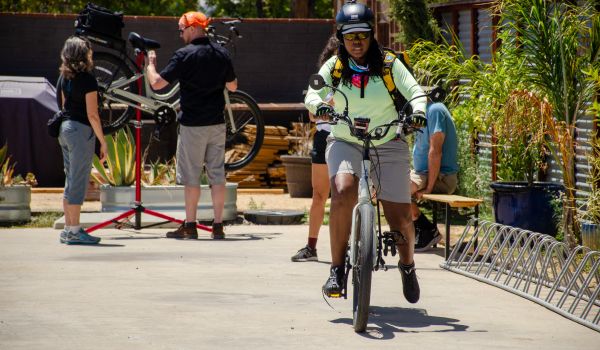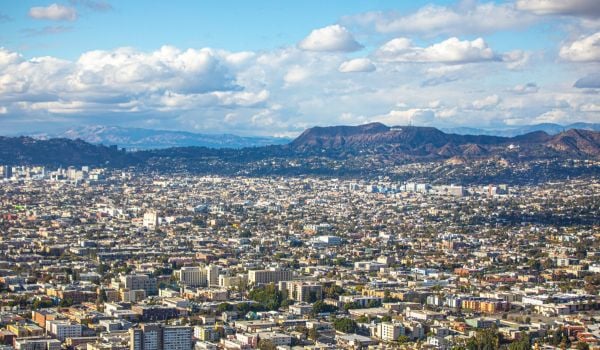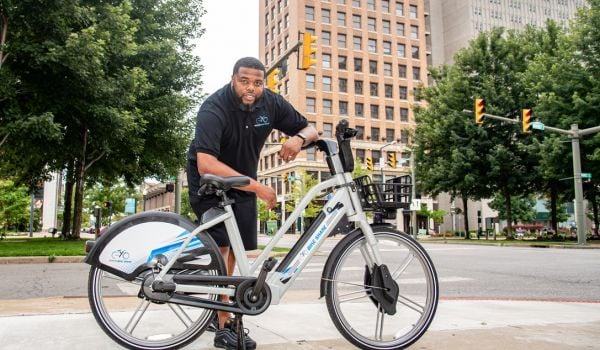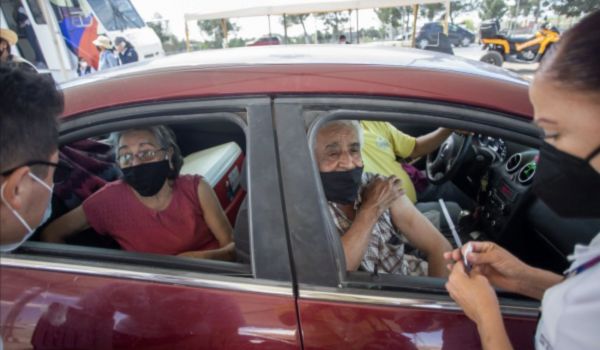Welcome to “The Mobile City,” our weekly roundup of noteworthy transportation developments.
The goal of the “complete streets” movement is to turn car drivers from the primary users of streets to just one set of users among many. Its promoters also hope that the street redesigns will reduce car use by making bicycling and walking more attractive. It turns out that giving bikes an electric-motor boost may do more to reduce car use than any other strategy, if a recent longitudinal study of bike riders in Oslo is any guide. Indeed, the introduction of e-bikes to bike-share systems across the country has led to a jump in bike use — but one city is bucking the trend, for the moment.
The COVID-19 pandemic, however, gives “complete streets” an entirely different meaning. One of the leading voices in the movement for complete streets, former New York City Transportation Commissioner Janette Sadik-Khan, now offers a menu of ways to repurpose city streets to do things other than move people around in this era of the “six-foot city.”
One repurposing Sadik-Khan did not mention in her essay is to use streets as COVID-19 testing sites. The Hawaii Department of Transportation has defied an order from the Federal Highway Administration, and converted a tunnel on one of Honolulu’s main freeways into a surge testing site.
E-Bike Users Ride More, Drive Less, Study Finds
Pedal-assist bikes, or “e-bikes,” are being added to bike-share fleets at a rapid clip in cities across the country. Their promoters see them as a way to boost bike ridership by extending the range bike riders can cover and helping them climb hills.
Until now, there’s been no solid data showing whether e-bikes realize that potential. We now have some data, and it’s encouraging.
Cycling Industry News reports on a study in Norway that finds that as e-bike users discover how much further they can travel in a given amount of time, they start using their bikes more and their cars less. The study of Oslo bicyclists found that e-bike users were traveling 340 percent further on average than they were on their strictly human-powered bikes: where they had been traveling an average of 1.3 miles on a regular bike, they now traveled 5.4 miles.
Some of the increase, they found, came from e-bike users simply using their bikes more often. The study also found that trips once taken by car or public transit had become e-bike trips; e-bike users on average increased the share of all trips they took by e-bike from 17 to 49 percent. Meanwhile, the share of total trips taken by human-powered bike remained flat.
The study also found that e-bike use continued to climb with the passage of time, rendering unlikely the possibility of a temporary “novelty effect” boost. The study focused on people who bought e-bikes for themselves rather than people who borrowed them for short-time use, which suggests that pedal-assisted bikes have huge potential to reshape urban mobility.
Bike-share system operators in a growing number of North American cities are looking to advance that potential by adding e-bikes to their fleets, but StreetsblogMASS reports that for now at least, Boston is one city that has declined to jump on the bandwagon. The Bluebikes network, which serves Boston and five adjacent municipalities, is operated by Lyft subsidiary Motivate. That company also operates bike-share systems in New York, Chicago and several other cities that are adding e-bikes to their fleets. But Bluebikes is owned by the communities it serves — the cities of Boston, Cambridge, Everett and Somerville, and the town of Brookline — and a spokesperson for the City of Boston told Streetsblog that “it is unlikely that we will add e-bikes to the Bluebikes fleet in the near future.”
The article gave several reasons why, including the fact that e-bikes are illegal for use on the city’s most popular bike paths. A bill now moving through the Massachusetts legislature will fix this, but several other objections remain, including distrust of the new technology and equity issues arising from higher cost of use. However, Becca Wolfson, executive director of the Boston Cyclists Union and a StreetsblogMASS board member, sees the equity issue from a different angle, one that she says should point toward the addition of e-bikes.
“A lot of lower-income communities and communities of color have less access to transit, and longer trips to jobs and services,” Wolfson said in a phone conversation with Streetsblog. “If e-bikes can reduce commute times and the amount of physical effort that’s required, that might actually help reduce the Boston region’s transportation inequities… The city has an obligation to explore this, to provide another, easier transportation option.”
How to Turn Streets into Outdoor Rooms in “The Six-Foot City”
The dropoff in travel attributed to the COVID-19 pandemic has already led to a wave of street repurposings in the cores of many American cities. The most common reclamation of space once used by cars is the conversion of parking spaces into dining spaces, used by restaurants whose social distancing requirements prevent them from fully using their existing indoor space. In some popular dining districts, such as Philadelphia’s Midtown Village, entire blocks have been closed to car traffic on weekends in order to give restaurants and their patrons some (literal) breathing room.
Now Janette Sadik-Khan, the former New York City transportation commissioner who has led the fight to take back streets from auto dominance, argues that cities should engage in more such closings in order to create socially distanced space for a host of other activities. Writing in The Guardian, she says that streets should become the basic building blocks of “the six-foot city.”
Noting that streets account for as much as 80 percent of all public open space in cities, Sadik-Khan says that the problem isn’t that there’s not enough space to create a “six-foot city,” but that it’s not properly allocated or configured. In her essay, she proposes several ways city blocks can be transformed into socially distanced activity centers: school classroom and activity space, polling stations for elections, curbside pickup and delivery, pedestrian shopping arcades, play streets and recreational space, and — of course — alternate means of transport.
“Cities where it’s possible to conduct many of life’s public activities safely — while maintaining the six feet [1.8 metres] of distance from one another that medical experts recommend — can mean the difference between a sputtering recovery that disrupts daily life, the global economy and democratic institutions, and a sustained, surging reopening that enables nations to grow and thrive, and not just survive,” she writes.
Hawaii Transportation Officials Defy the Feds and Set Up COVID-19 Test Site in a Freeway Tunnel
As most of you should know, even Hawaii has Interstate highways. Of course, the three Interstates on Oahu don’t lead to anywhere off that island, but they were built with Interstate highway funds.
Hawaii’s three main Interstates connect the military facilities around Pearl Harbor to other points on the island. The newest, Interstate H-3, is also the only one that crosses the mountains in the middle of the island on its way from Pearl Harbor to the Marine base at Kaneohe.
According to a report in Honolulu Civil Beat, Hawaii transportation officials were well advanced with plans to convert the main tunnel on the highway, the Tetsuo Harano Tunnel, into a pop-up free COVID-19 testing site on Sept. 1 when they got an email from the Federal Highway Administration telling them they couldn’t do it. They went ahead anyway.
Ed Sniffen, deputy director for highways at the Hawaii Department of Transportation, had sent the request to close the H-3 tunnel to his state FHWA counterpart the Friday before. “We believe H-3 is needed for testing as all other sites used to date, whether it be for COVID-19 testing, food distribution or other public benefit efforts have resulted in significant traffic, delay and safety impacts to the immediate site and neighboring facilities,” Sniffen wrote.
The response from Ralph Rizzo, the director of FHWA’s Hawaii Division, cited both safety concerns and the road’s role in connecting two military facilities as grounds for denial: “We are extremely concerned about the impacts that the closure and temporary alternative use of Interstate H-3 will have, as well as the precedent that closing H-3 for health testing will set,” he wrote.
As the response came 45 minutes before testing was to start, Hawaii DOT went ahead with its plans despite the threat that it might lose Federal highway funds. Sniffen noted that the Interstate has five miles of approach roads leading to the tunnel on either side that could be used to queue vehicles waiting for tests.
According to the Civil Beat story, the state planned to repeat the pop-up on Thursday, Sept. 3, and it was supposed to send an explanation to the FHWA for why it went ahead with the plan. KTTV reported after the first pop-up that total visits were below the 5,000 expected and that things ran smoothly.

Next City contributor Sandy Smith is the home and real estate editor at Philadelphia magazine. Over the years, his work has appeared in Hidden City Philadelphia, the Philadelphia Inquirer and other local and regional publications. His interest in cities stretches back to his youth in Kansas City, and his career in journalism and media relations extends back that far as well.
Follow Sandy .(JavaScript must be enabled to view this email address)

